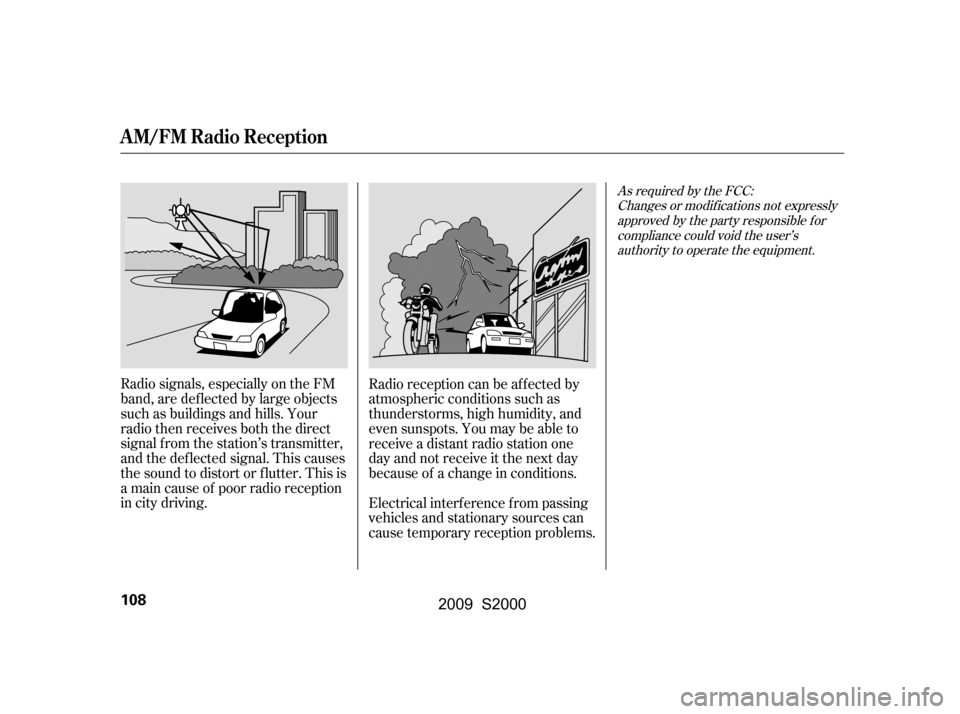2009 HONDA S2000 ESP
[x] Cancel search: ESPPage 111 of 268

Radio signals, especially on the FM
band, are def lected by large objects
such as buildings and hills. Your
radio then receives both the direct
signal f rom the station’s transmitter,
and the def lected signal. This causes
the sound to distort or flutter. This is
a main cause of poor radio reception
in city driving.Radio reception can be af f ected by
atmospheric conditions such as
thunderstorms, high humidity, and
even sunspots. You may be able to
receive a distant radio station one
day and not receive it the next day
because of a change in conditions.
Electrical interf erence f rom passing
vehicles and stationary sources can
cause temporary reception problems.
As required by the FCC:
Changes or modif ications not expresslyapproved by the party responsible f orcompliance could void the user’sauthority to operate the equipment.
A M/FM Radio Reception
108
2009 S2000
Page 116 of 268

Depending on where you drive, you
may experience reception problems.
Interf erence can be caused by any of
these conditions:Driving on a road beside a vertical
wall, steep clif f , or hill to the south
of you.
Driving on the north side of a
large commercial truck on an
east/west road.
Driving in tunnels.
Driving on a single lane road
alongside dense trees taller than
50 ft. (15 m) to the south of you.
Driving on the north side of an
east/west mountain road. There may also be other geographic
situations that could af f ect satellite
radio reception.
If you decide to purchase XM radio
service, contact XM
Radio at
,orat 1-800-852-9696. You will need to give
them your radio I.D. number and
your credit card number. To get your
radio I.D. number, turn the TUNE
knob until ‘‘0’’ appears in the display.
Your I.D. will appear in the display.
After you’ve registered with XM
Radio, keep your audio system in the
XM Satellite Radio mode while you
wait f or activation. This should take
about 30 minutes.
While waiting for activation, make
sure your vehicle remains in an open
area with good reception. Once your
audio system is activated, ‘‘category’’
or ‘‘CH’’ will appear in the display,
andyou’llbeabletolistentoXM
Radio broadcasts. XM Satellite Radio
will continue to send an activation
signal to your vehicle f or at least 12
hours from the activation request. If
the service has not been activated
af ter 36 hours, contact XM Satellite
Radio.
Driving on the lower level of a
multi-tiered road.
If your XM Radio service has expired,
or you purchased your vehicle f rom
a previous owner, you can listen to a
sampling of the broadcasts available
on XM Satellite Radio. With the
ignition switch in the ACCESSORY
(I) or ON (II) position, push the
PWR/VOL knob to turn on the audio
system, and press the CD/AUX
button. A variety of music types and
styles will play.
As required by the FCC:
Changes or modif ications not expresslyapproved by the party responsible f orcompliance could void the user’sauthority to operate the equipment.
www.xmradio.com
Playing the XMSatellite Radio (Optional on U.S. Models)
Receiving XM Radio Service
Features
113
2009 S2000
Page 155 of 268

When VSA activates, you may notice
that the engine does not respond to
the accelerator in the same way it
does at other times.
The VSA system cannot enhance the
vehicle’s driving stability in all
situations and does not control your
vehicle’s entire braking system. It is
still your responsibility to drive and
corner at reasonable speeds and to
leave a sufficient margin of safety.When VSA activates, you will see the
VSA activation indicator blink (see
page ).
The vehicle stability assist (VSA)
system helps to stabilize the vehicle
during cornering if the vehicle turns
more or less than desired. It also
assists you in maintaining traction
while accelerating on loose or
slippery road surf aces. It does this
by regulating the engine’s output and
by selectively applying the brakes. If this indicator comes on while
driving, pull to the side of the road
when it is saf e, and turn of f the
engine. Reset the system by
restarting the engine. If the VSA
system indicator stays on or comes
back on while driving, have the VSA
system inspected by your dealer.If the indicator does not come on
when the ignition switch is turned to
the ON (II) position, there may be a
problem with the VSA system. Have
your dealer inspect your vehicle as
soon as possible (see page ).
Without VSA, your vehicle still has
normal braking and cornering ability,
but it does not have VSA traction and
stability enhancement.
The VSA system indicator may come
on along with the ABS indicator if
there is a problem with the anti-lock
brake system.
The main f unction of the
VSA system is generally known as
Electronic Stability Control (ESC).
The system also includes a traction
control f unction. 50
50
VSA A ctivation Indicator
VSA System Indicator
Vehicle Stability A ssist (VSA), aka Electronic Stability Control (ESC), System
152
NOTE:
2009 S2000
Page 159 of 268

As required by the FCC:This device complies with Part 15 of theFCC rules. Operation is subject to thef ollowing two conditions: (1) This devicemay not cause harmf ul interf erence, and(2) this device must accept anyinterf erence received, includinginterf erence that may cause undesiredoperation.
Changes or modif ications not expresslyapproved by the party responsible f orcompliance could void the user’sauthority to operate the equipment.
This device complies with IndustryCanada Standard RSS-210.Operation is subject to the f ollowing twoconditions: (1) this device may not causeinterf erence, and (2) this device mustaccept any interf erence that may causeundesired operation of the device.
CR models
If you have a f lat tire, the low tire
pressure indicator will come on.
Repair the f lat tire with the tire
repair kit (see page ).
Each wheel is equipped with a tire
pressure sensor mounted inside the
tire behind the valve stem. You must
use TPMS specif ic wheels. It is
recommended that you always have
your tires serviced by your dealer or
a qualif ied technician.
Af ter you repair the f lat tire, the low
tire pressure indicator may come on.
This is normal; the system is not
monitoring the repaired tire pressure.
Havetheflattirerepairedbythe
dealer as soon as possible.
Never use a puncture-repairing agent
in a f lat tire. If used, you will have to
replace the tire pressure sensor.
Havetheflattirerepairedbyyour
dealer as soon as possible.
After you replace the flat tire with
thecompactsparetire,thelowtire
pressure indicator stays on. This is
normal; the system is not monitoring
the spare tire pressure. Manually
check the spare tire pressure to be
sure it is correct. Af ter several miles
(kilometers) driving with the
compact spare tire, the TPMS
indicator comes on and the low tire
pressure indicator goes of f .
The low tire pressure indicator or
the TPMS indicator will go off, after
several miles (kilometers) driving,
when you replace the spare tire with
the specif ied regular tire equipped
with the tire pressure monitor sensor. 206
Tire Pressure Monitoring System (TPMS)
Repairing a T ire with T PMS
156
2009 S2000
Page 203 of 268

Replace the tire when you can see
the tread wear indicator bars. The
replacement should be the same size
and design tire, mounted on the
samewheel.Thesparetireisnot
designed to be mounted on a regular
wheel, and the spare wheel is not
designed f or mounting a regular tire.
Check the inf lation pressure of the
compact spare tire every time you
check the other tires. It should be
inf lated to:
Use the compact spare tire as a
temporary replacement only. Get
your regular tire repaired or replaced,
and put it back on your vehicle as
soon as you can.
Follow these precautions:
Never exceed 50 mph (80 km/h).
This tire gives a harsher ride and
less traction on some road
surf aces. Use greater caution
while driving.
Do not mount tire chains on the
compact spare tire. Do not use your compact spare
tire on another vehicle unless it is
thesamemakeandmodel.
Do not mount the compact spare
tire on either rear wheel position;
it will damage the limited slip
dif f erential (see page ).
The low tire pressure indicator
comes on and stays on af ter you
replace the flat tire with the
compact spare tire. Af ter several
miles (kilometers) driving with the
compact spare tire, the TPMS
indicator comes on and the low
tire pressure indicator goes of f .
201
Except CR models
Compact Spare Tire
200
INDICATOR LOCATION MARK
TREAD WEAR INDICATOR BAR
60 psi (420 kPa , 4.2 kgf/cm)
2009 S2000
Page 208 of 268

Put the flat tire in the trunk well
vertically as shown.
Remove the tool box f rom the
trunk well, and replace the jack,
wheel wrench, and extension in
the tool box.
Place the tool box into the spare
tire shelf in the trunk.
Replacethesparetirecover.
Secure it with the three clips. Push
each clip in securely, and pivot the
ring down f lat.Your vehicle’s original tire has a
tire pressure monitoring system
sensor. To replace a tire, ref er to (see
page ). 155
17.
18.
16.
14.
15.
Changing a Flat Tire
Changing a T ire with T PMS
T aking Care of t he Unexpect ed
205
CLIPS
SPARETIRECOVER
TOOL BOX
2009 S2000
Page 227 of 268

If you cannot drive the vehicle
without f ixing the problem, and you
do not have a spare fuse, take a fuse
of the same rating or a lower rating
f rom one of the other circuits. Make
sureyoucandowithoutthatcircuit
temporarily (such as the accessory
power socket or radio).
If you replace the blown f use with a
spare f use that has a lower rating, it
might blow out again. This does not
indicate anything wrong. Replace the
f use with one of the correct rating as
soon as you can.If the replacement fuse of the
same rating blows in a short time,
there is probably a serious
electrical problem with your
vehicle. Leave the blown fuse in
that circuit, and have your vehicle
checked by a qualif ied technician.
Look f or a blown wire inside the
f use. If it is blown, replace it with
oneof thesparefusesof thesame
rating or lower. 6.
5.
Fuses
224
BLOWN
Replacing a f use with one that has a
higher rating greatly increases the
chances of damaging the electrical
system. If you do not have a
replacement f use with the proper rating
f or the circuit, install one with a lower
rating.
2009 S2000
Page 240 of 268

The temperature grades are A (the
highest), B, and C, representing the
tire’s resistance to the generation of
heat and its ability to dissipate heat
when tested under controlled
conditions on a specif ied indoor
laboratory test wheel. Sustained high
temperature can cause the material
of the tire to degenerate and reduce
tire life, and excessive temperature
can lead to sudden tire f ailure. The
grade C corresponds to a level of
perf ormance which all passenger car
tires must meet under the Federal
Motor Vehicle Saf ety Standard No.
109. Grades B and A represent
higher levels of perf ormance on the
laboratory test wheel than the
minimum required by law.Warning: The temperature grade f or
this tire is established f or a tire that
is properly inf lated and not
overloaded. Excessive speed,
underinf lation, or excessive loading,
either separately or in combination,
can cause heat buildup and possible
tire f ailure.
DOT Tire Quality Grading (U.S. Vehicles)
Temperature
Technical Inf ormation
237
2009 S2000